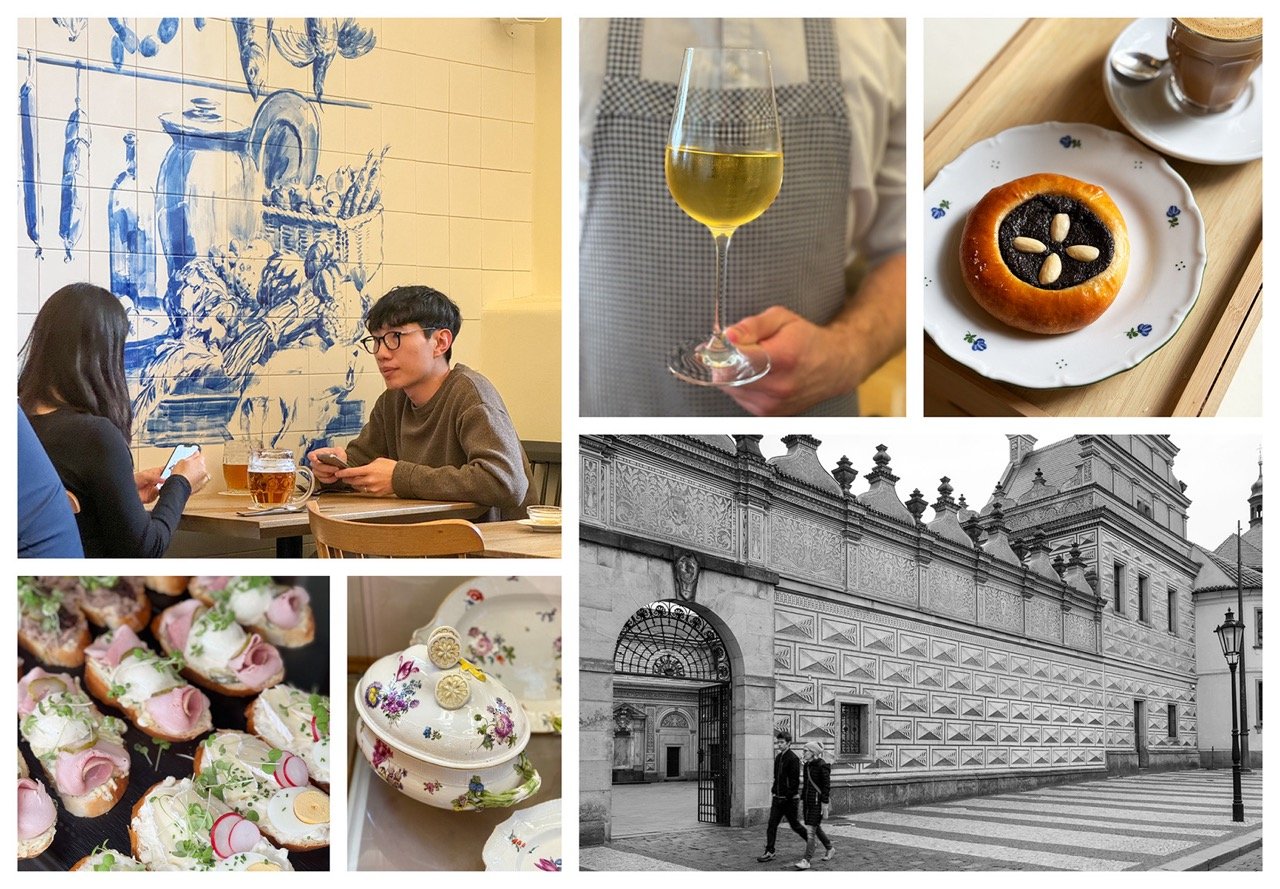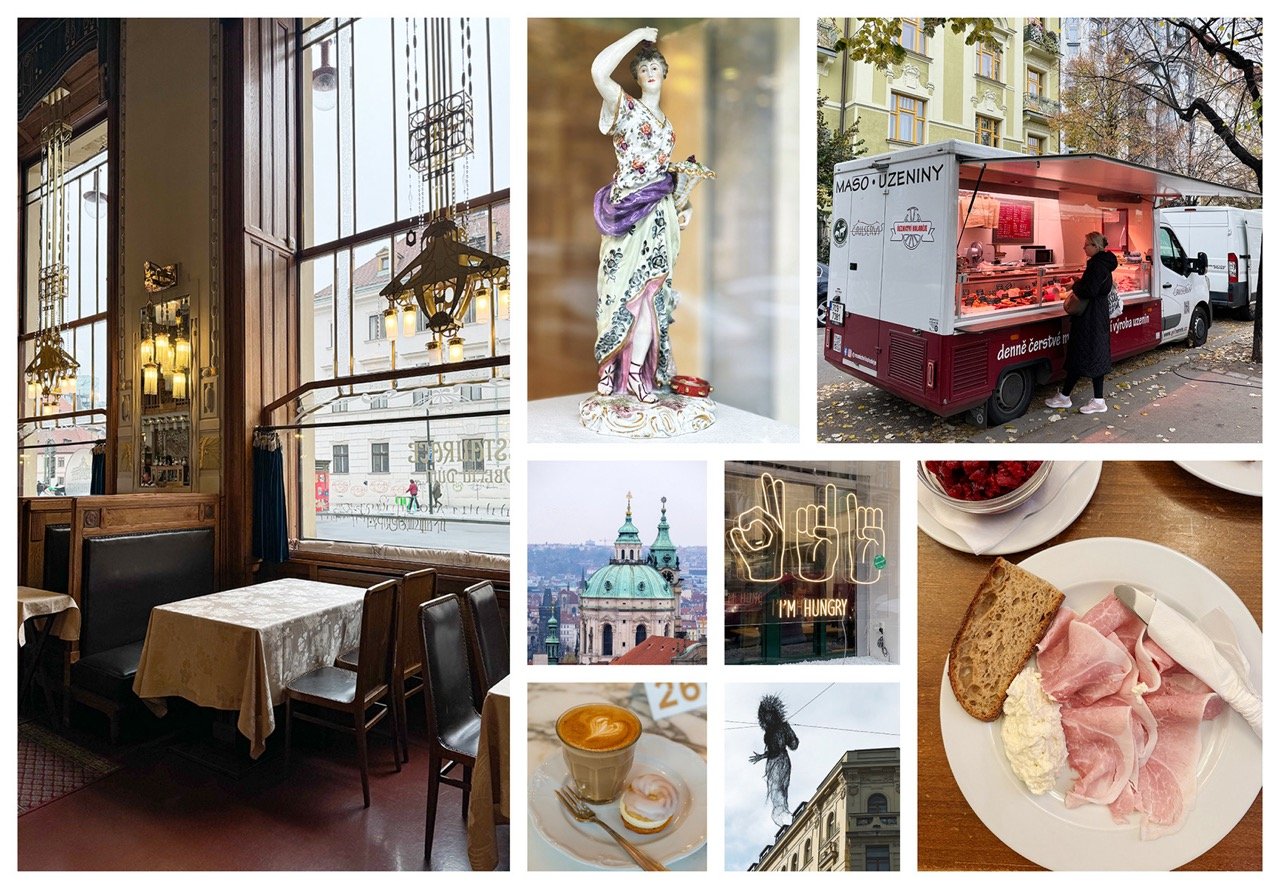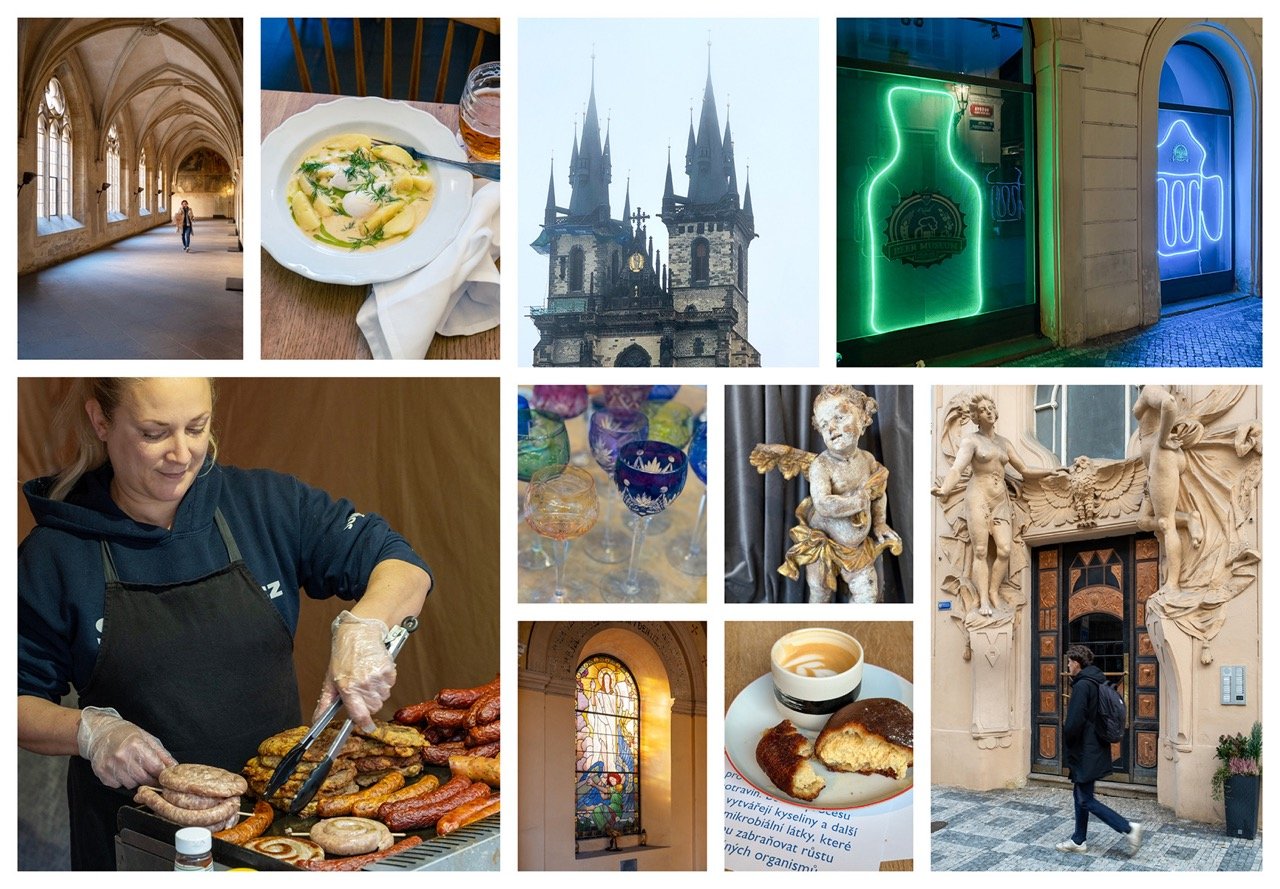A first-timer’s Prague. Part 2
By Leanne Kitchen
Here’s the second part of my recent journey to Prague—a city I loved so much, I’m already planning my next visit. If you’re at all keen on exploring the city of Mucha, Pilsner, classic cafés, and a million golden buchty, you might find a few travel ideas here. (By the way, I can't recommend Richard Fidler’s brilliant book The Golden Maze enough if, like me, you're fascinated by the history of this incredible place. It’s a sweeping exploration that’s surprisingly accessible, whether you’re a dedicated history buff or just a casual reader with plenty of curiosity).
Click here for: A first-timer’s Prague. Part 1
Day 4.
Determined to see the Charles Bridge early, I peel myself out of bed to get there by 6 a.m. and even then, I’m hardly alone. There’s already a small battalion of photographers with their tripods, each staking out the same moody angle like they’re the paparazzi. Despite them, the mist hangs low, the lamps still glow, and the bridge feels like it belongs to an earlier century, which it arguably does – the fourteenth, to be precise. It’s beautifully atmospheric with its Baroque-era statues, although the ones on the bridge are replicas – the originals are in museums (like the Lapidarium of the National Museum) for their own protection.
Starving and somewhat chilled by now, I head over to Eska in Karlín. It’s an ultra-modern café slash bakery slash restaurant in one of Prague’s most exciting up-and-coming neighbourhoods, and I wolf down buchty s tvarohem, a sweet yeasted bun filled with a type of farmer’s cheese, like there’s no tomorrow. It’s fabulous, but all the baking and other menu items are next level. (Other great cafes I quickly checked out during my visit include Alf&Bet, Zrno Zrnko, Oh Deer, Pekárna Praktika and EMA Espresso Bar).
After breakfast I take a riverbank walk back to Café Myšák in Nové Město. The aim is more yet coffee and sweet carbs, because why not follow up Czech breakfast with Czech pastry? It’s a 6km walk and by the time I reach the dreamy belle-époque confection that is Myšák, I’m pretty ready for that creamy, custardy větrník, the local version of a sweet choux puff. Fun fact; the cafe is famous for their vanilla-caramel ice cream sundae, called the Myšák Cup.
Later I meet the Trav Bud for a late lunch of Prague ham, crispy schnitzel and beetroot salad at Lokál Dlouhááá; I really love the whole modern beer hall concept of the Lokál eateries; there are 8 in total and if I only ate in them, I wouldn’t be mad about it. On my way to lunch I poke my nose into the art nouveau gloriousness that is the Obecní Dům ( Municipal House). I don’t have time for the guided tour, dammit, much less a concert in the gorgeous concert hall, but the gist is this: the building was completed in 1911 as a cultural hub and was where Czechoslovakia was proclaimed an independent state in 1918. The stained-glass windows and large murals are by Alfons Mucha, and the façade is adorned with allegorical figures representing virtues like industry, commerce, and education. The whole thing is astoundingly beautiful and I’d urge you to not be like me and to take the damn tour.
Speaking of the iconic Czech artist Mucha, we visit the Mucha Museum later in the day. There are over 300 works (lovely posters, prints, and sketches) charting Mucha’s rise from commercial artist to iconic, era-defining illustrator, and it’s a delightfully digestible museum. I confess we never made it to St Vitus Cathedral to see his famous stained glass windows but that’s one for next time.
PRO TIPS
Czech Pilsner Pouring Tip: When you order a Czech pilsner, expect a large head of foam—it’s not a mistake! This style of pouring is called ‘hladinka’ and it preserves the beer's aroma, texture, and carbonation. Don’t ask for it without foam—it’s bad form!
Art Nouveau Walking Tour: If you can’t take a tour of the Municipal House, consider a self-guided Art Nouveau walking route in Prague. Check out other architectural treasures like the stunning Hotel Paris and the Grand Hotel Europa on Wenceslas Square.
Day 5.
The day kicks off at Café Savoy, a real Prague institution. Established in 1893, it’s where political debates and coffee have long percolated under the Art Nouveau ceilings, ornate chandeliers, and polished brass fittings. We order coffee, cake and pastries, but the classic cooked breakfasts on other tables give us real FOMO vibes.
From the Savoy a short stroll takes us to Kampa Park, just off the Charles Bridge, where we encounter more of David Černý’s provocative sculptures. First some of his Czech Babies, with their creepy, oversized heads, exaggerated features, and crawling bodies. Then we spot his quirky yellow penguins lined up along the Vltava. There’s no deep meaning to any of these works apparently—they’re Černý making you do a double take and wonder if you’re missing some cryptic message. We have no idea if we are but we chalk them up as being a fun find.
On a crowd-skipping tip from a local, we make for the Lobkowicz Palace, tucked within the Prague Castle complex but still privately owned. Inside, the aristocratic Lobkowicz family’s collection stuns: highlights include Canaletto, Velázquez and Bruegel paintings, jaw-dropping porcelain, and some handwritten Beethoven manuscripts. The pièce de résistance? The palace’s café with killer views across the city. We time our exit perfectly to catch the crowd-pleasing Changing of the Guard at the nearby castle gates; it’s weirdly stirring and worth a quick watch if you’re already here.
Our lunch was booked weeks ago at Kuchyň, and oh man, what a treat this place is. The interior is smart-casual with an open kitchen, breezy service and a modern approach to classic Czech fare. Plus, there’s a lovely terrace with views for when the weather’s nice. Trav Bud demolishes duck with cabbage, apple, and knedlíky (Czech bread dumplings), while I dive into potatoes and perfectly boiled eggs smothered in koprová omáčka—a creamy, sweet-sour dill sauce that’s one of the best things I’ve eaten in a long time. Paired with top-notch local white wine, the meal steals the show as the dining highlight of our trip.
The day wraps with a guided tour through Villa Müller, a modernist masterpiece by architect Adolf Loos who famously hated ornamentation. Built in the 1930s and still wonderfully original, it’s an art deco dream for nerds like me although sadly (but understandably) we’re not allowed to take pics inside the house.
PRO TIPS
Lobkowicz Palace: Don't miss the audio guide—it’s narrated by the Lobkowicz family themselves and adds some personal insight.
Prague Castle Food Tip: If Kuchyň is fully booked, try St. Martin, a nearby restaurant serving Czech dishes with a modern twist, including vegetarian-friendly options.
Villa Müller Access: Book your tickets online in advance for Villa Müller, as visitor numbers are very restricted. The guided tour is really worth it.
Day 6
It’s our last day, and I find myself asking – WHO BOOKS JUST 6 DAYS IN PRAGUE ANYWAY? I’m kicking myself over this as we start off at the Vinohrady Farmers’ Market for breakfast, and to buy a few edible souvenirs. A bag of handmade cookies, a hunk of local cheese for a long bus ride later, and a jar of plum jam—my haul is modest, but neither do I want to rumble with customs officers when I get home. It’s a pity I can’t slide in a jar or two of delicious škvarková pomazánka (pork crackling spread), which is unreal on rustic bread. Smaller than Náplavka, the market has a warmth and unpretentiousness that makes it feel like a secret, although it’s really not.
Pasáž Světozor is next, another of Prague’s iconic pedestrian arcades. The star attraction? The Tesla window—a 1947 stained glass work of bold, modernist design. It’s a striking relic of a different era and I try not to wreck the moment by thinking about Elon.
With time running out, the pressure’s on to cram in a few more last places and decisions have to be made: art nouveau Café Imperial or riverside Café Slavia? Slavia wins and we nurse coffees while soaking in the postcard-perfect view of Prague Castle through tall, minimalist windows as the city’s iconic red trams rumble by. Inside, the art deco vibe is intoxicating—marble floors, heavy velvet curtains, and formally-attired staff. In the 20th century this place was the epicentre of Prague’s intellectual life and a meeting place for artists, poets, theorists and revolutionaries. If those walls could talk!
My pilgrimage to Perníčkův Sen in Malá Strana is next. A teeny gingerbread shop, it’s a trove of intricately hand-formed, hand-decorated cookies, ranging from traditional heart shapes sandwiched with jam, to elaborately iced miniatures of Prague landmarks. The range is tantalising and so is the smell; the whole shop is heady with sugar and sweet spices. I leave with more gingerbread than anyone really needs, fully aware it won’t all make it back to the friends it’s intended for. (S-o-r-r-y).
Around the corner is the Monastery of St. Agnes of Bohemia, an outpost of the National Gallery of Prague and stuffed with Gothic art treasures. I hadn’t planned a visit but I love Gothic art and it turns out to be a good decision. Altarpieces glint with gold leaf, religious panels bristle with intensity, and the monastery’s haunting beauty amplifies it all. It’s uncrowded and the kind of deeply atmospheric place that really stays with you.
Later, I sadly farewell Prague over dinner at smart-casual Kantýna, where locals and tourists alike queue for plates of no-frills fare; you grab a tray, join the line at the counter and point to what tempts from bain maries or the daily menu. It’s bustling and unapologetically meat-centric – carpaccio and boiled beef neck with dill sauce and the inevitable (but delicious) bread dumplings are our picks. The quality meats are sourced locally, the menu changes daily, and there’s a wonderful butcher’s shop out the front. Oh and the essential fresh beer too! Perfection. If there’s a better way to end our visit than with rounds of pilsner, flavoursome Czech beef and a happy vibe, I want to know it.
PRO TIPS
Perníčky 101: Czech gingerbread is unique because it’s often aged to allow the spices to meld. So if you’re buying some to take home or gift, it will improve with time.
Pasáž Světozor Tip: While at the Světozor arcade, pop into Světozor Cinema. This arthouse gem has a retro vibe, and if you’re short on time, just swing by for their ice cream stand, known for unusual flavours like poppy seed or pistachio.
The Czech Beer Rule: At casual spots like Kantýna, learn to say "ještě jedno pivo prosím" (another beer, please). Beer is served fresh and unfiltered—straight from the tank.
NOTES ON CZECH FOOD
Czech Cuisine is Very Meaty - Expect a lot of pork, beef, and sausages, often served with rich sauces. Iconic dishes like svíčková (braised beef in creamy root vegetable sauce) and vepřo knedlo zelo (roast pork with sauerkraut and dumplings) are staples.
Dumplings Galore - Czech meals often come with knedlíky (steamed or boiled dumplings). These are pillowy slices of dough or bread, perfect for mopping up sauces. They're delicious but very filling, so pace yourself!
Not an Everyday Diet - The hearty dishes are great for a big meal after a day of walking or in cooler weather, but they’re not light fare for everyday eating. Even many locals reserve these dishes for special occasions or Sunday lunches.
Lighter Options Exist - If you’re craving something less heavy, look for meals like smažený sýr (fried cheese), a vegetarian-friendly dish often served with tartar sauce and potatoes, or bramboráky (crispy potato pancakes).
Seasonal Game Dishes Shine - During autumn, Czech menus often feature game meats like venison, wild boar, and duck, paired with red cabbage or dumplings. These are a delicious, seasonal treat.
Soups to Start - Czechs love their soups, and they can be a lighter alternative to main meals for a break. Try česnečka (garlic soup) or kulajda (dill cream soup with mushrooms).
Pubs are the Best Places for Traditional Fare - For an authentic experience, head to a hospoda (pub). These often serve simple, traditional meals designed to pair perfectly with a beer.
Beer Completes the Experience - A light Pilsner pairs beautifully with the heavy dishes and cuts through the richness.













